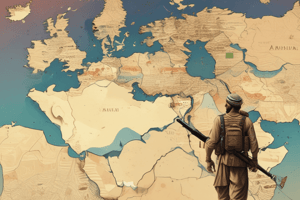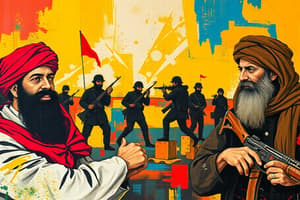Podcast
Questions and Answers
The Taliban remained in power in Afghanistan until?
The Taliban remained in power in Afghanistan until?
- 1996
- 2001 (correct)
- 2012
- 1990
Why did Saddam Hussein use weapons of mass destruction against the Kurdish people and Shiite Muslims?
Why did Saddam Hussein use weapons of mass destruction against the Kurdish people and Shiite Muslims?
They rebelled against Saddam Hussein's rule.
Why did Saudi Arabia fear an Iraqi invasion?
Why did Saudi Arabia fear an Iraqi invasion?
Iraq invaded nearby Kuwait for its oil.
By attacking the USS Cole, al-Qaeda ultimately aimed to?
By attacking the USS Cole, al-Qaeda ultimately aimed to?
The Department of Homeland Security was created to?
The Department of Homeland Security was created to?
On what basis did al-Qaeda most likely choose its first American bombing targets?
On what basis did al-Qaeda most likely choose its first American bombing targets?
As part of the war on terror, what action did the United States take in Afghanistan?
As part of the war on terror, what action did the United States take in Afghanistan?
Operation Desert Storm was the name of?
Operation Desert Storm was the name of?
At the end of the Persian Gulf War, what did Iraq agree to do? Check all that apply.
At the end of the Persian Gulf War, what did Iraq agree to do? Check all that apply.
What best characterizes Iraq and Afghanistan today?
What best characterizes Iraq and Afghanistan today?
After the attacks of September 11, 2001, the United States demanded that?
After the attacks of September 11, 2001, the United States demanded that?
Arab forces most likely fought with the United States in the Gulf War because?
Arab forces most likely fought with the United States in the Gulf War because?
Why was the U.S. invasion of Iraq controversial?
Why was the U.S. invasion of Iraq controversial?
Al-Qaeda's main targets on September 11, 2001, were?
Al-Qaeda's main targets on September 11, 2001, were?
Flashcards are hidden until you start studying
Study Notes
Taliban Control in Afghanistan
- The Taliban ruled Afghanistan until 2001, when they were overthrown following the U.S. invasion.
Saddam Hussein and Weapons of Mass Destruction
- Saddam Hussein targeted Kurdish people and Shiite Muslims with weapons of mass destruction because they rebelled against his regime.
Saudi Arabia's Fears During Gulf War
- Saudi Arabia was concerned about potential Iraqi invasion due to Iraq’s prior invasion of Kuwait for oil resources.
Al-Qaeda’s Motivations
- The attack on the USS Cole by al-Qaeda was intended to send a violent warning to the United States.
Creation of the Department of Homeland Security
- The Department of Homeland Security was established to protect the United States from terrorist attacks following 9/11.
Al-Qaeda's Target Selection
- Al-Qaeda’s first American bombing targets were chosen because they were located in Africa, which is close to the Middle East.
U.S. Actions in Afghanistan
- As part of the war on terror, the U.S. successfully drove the Taliban out of power in Afghanistan.
Operation Desert Storm
- Operation Desert Storm refers specifically to the ground invasion in Kuwait during the Gulf War.
Iraq's Agreements Post-Persian Gulf War
- At the end of the Persian Gulf War, Iraq agreed to eliminate any long-range missiles and recognize Kuwait’s right to exist independently.
Current Situation in Iraq and Afghanistan
- Both Iraq and Afghanistan continue to struggle with unrest and instability in their governments.
U.S. Demands Post-9/11 Attacks
- After the September 11 attacks, the U.S. demanded that the Taliban government in Afghanistan turn over Osama bin Laden.
Arab Forces in the Gulf War
- Arab forces allied with the United States during the Gulf War primarily to protect their own resources.
Controversy Over U.S. Invasion of Iraq
- The U.S. invasion of Iraq was controversial as many disagreed that Iraq posed a significant terrorist threat.
Al-Qaeda's September 11 Targets
- On September 11, 2001, al-Qaeda targeted New York City and Washington, D.C. as key locations for their coordinated attacks.
Studying That Suits You
Use AI to generate personalized quizzes and flashcards to suit your learning preferences.




